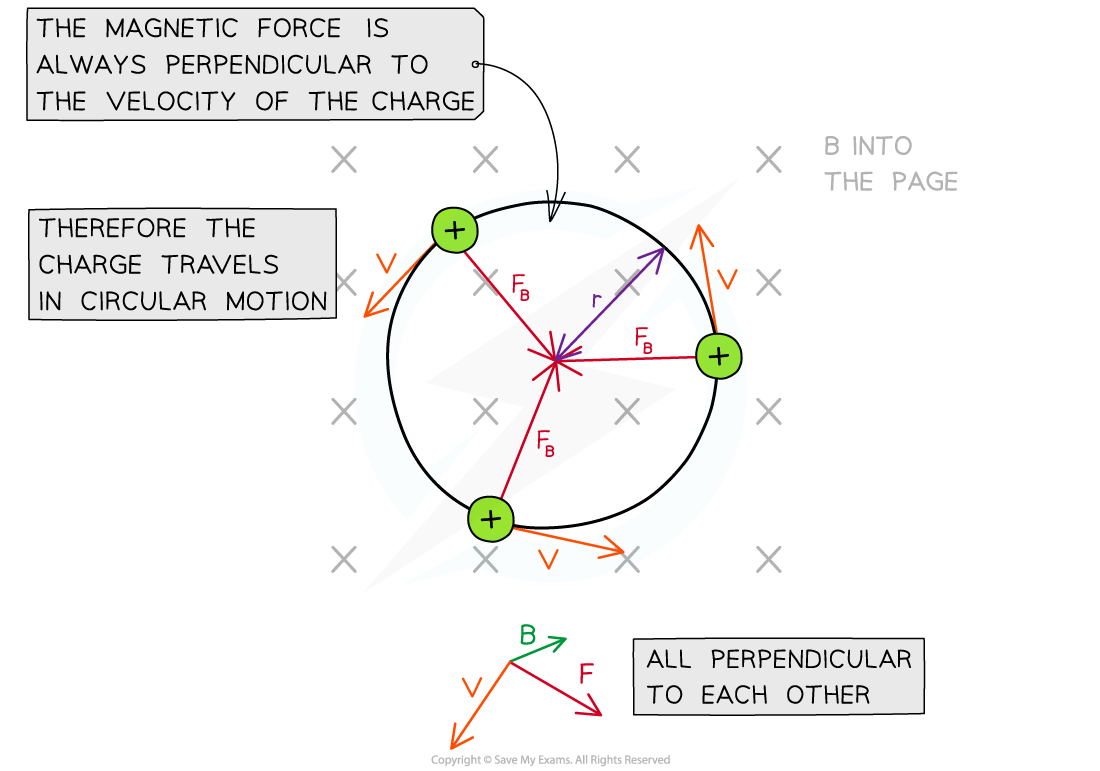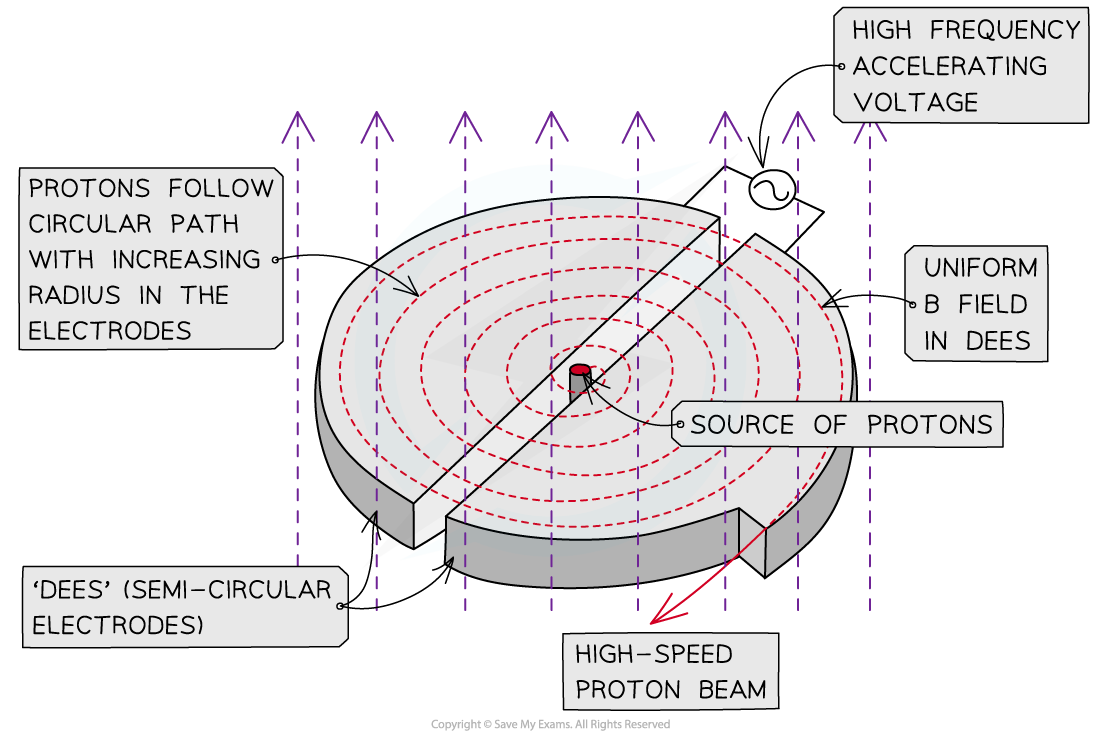Circular Path of Particles (AQA A Level Physics) : Revision Note
Motion of a Charged Particle in a Magnetic Field
When a charged particle enters a uniform magnetic field, it travels in a circular path
This is because the direction of the magnetic force F will always be
perpendicular to the particle's velocity v
directed towards the centre of the path, resulting in circular motion

In a magnetic field, a charged particle travels in a circular path as the force, velocity and field are all perpendicular
The magnetic force F provides the centripetal force on the particle
The equation for centripetal force is:
Equating this to the magnetic force on a moving charged particle gives the expression:
Rearranging for the radius r gives an expression for the radius of the path of a charged particle in a perpendicular magnetic field:
Where:
r = radius of the path (m)
m = mass of the particle (kg)
v = linear velocity of the particle (m s−1)
B = magnetic field strength (T)
Q = charge of the particle (C)
This equation shows that:
Faster moving particles with speed v move in larger circles (larger r):
Particles with greater mass m move in larger circles:
Particles with greater charge q move in smaller circles:
Particles moving in a strong magnetic field B move in smaller circles:
The centripetal acceleration is in the same direction as the magnetic (centripetal) force
This can be found using Newton's second law:
Cyclotrons
A cyclotron is a type of particle accelerator which
makes use of the circular trajectory of charged particles in a magnetic field to create a spiral path
accelerates charged particles, such as protons, to very high speeds
Cyclotrons have many medical applications, such as:
to produce tracers for imaging
to create high-energy beams of radiation for radiotherapy
Cyclotrons consist of:
two hollow semicircular electrodes called 'dees'
a strong uniform magnetic field
an alternating electric field

A cyclotron is a type of particle accelerator that utilises electric and magnetic fields to create high-energy beams of charged particles, such as protons
Function of a Cyclotron
1. Entering the dees
There is a source of charged particles at the centre of the cyclotron
A magnetic field is applied perpendicular to the path of the particles
A magnetic force acts in a direction perpendicular to the field and the path of the particles
This causes the particles to move in a circular path when inside the dees
2. Crossing the gap between dees
There is a gap between each semi-circular dee
An electric field is applied in the gaps between the dees
An electric force acts on the charged particles causing them to accelerate
This causes them to enter the next dee at a higher speed and follow a path with a larger radius
3. Leaving the dees
The charged particles travel with constant speed in the dees
This means the time spent in one dee is constant
The direction of the electric field alternates each time the particles reach a gap
This means they will always accelerate towards the opposite dee
This process repeats as the particles spiral outwards until they leave the cyclotron at the desired speed
Role of the magnetic field in a cyclotron
In a cyclotron, the role of the uniform magnetic field is
To supply the centripetal force needed to keep the particles moving in circular motion
As the charged particles travel around a single dee they
follow a circular path of constant radius
move at a constant speed
Role of the electric field in a cyclotron
In a cyclotron, the role of the alternating electric field is
To accelerate the particles between the dees
As the charged particles travel across the gap between dees they
gain additional energy = QV
move faster and follow a path with a larger radius as they enter the next dee
Worked Example
An electron travels at right angles to a uniform magnetic field of flux density 6.2 mT. The speed of the electron is 3.0 × 106 m s−1.
Calculate the radius of the circular path of the electron.
Answer:
Step 1: List the known quantities
Electron charge-to-mass ratio =
= 1.76 × 1011 C kg−1 (from formula sheet)
Magnetic flux density, B = 6.2 mT = 6.2 × 10−3 T
Speed of the electron, v = 3.0 × 106 m s−1
Step 2: Write an expression for the radius of an electron in a magnetic field
centripetal force = magnetic force
Step 3: Substitute the known values into the expression
mm
Examiner Tips and Tricks
Make sure you're comfortable with deriving the equation for the radius of the path of a particle travelling in a magnetic field, as this is a common exam question.
Similar to orbits in a gravitational field, any object moving in circular motion will obey the equations of circular motion. Make sure to refresh your knowledge on these equations. They will be in the 'Circular Motion' section of the data sheet, and not under 'Magnetic Fields'.

You've read 0 of your 5 free revision notes this week
Sign up now. It’s free!
Did this page help you?
